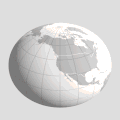Geodesy
Geodesy, sometimes called geodetics, is a scientific branch of geography which accurately measures the surface of the Earth.
| Geodesy | |
|---|---|
 | |
| Fundamentals | |
| Geodesy · Geodynamics Geomatics · Cartography | |
| Concepts | |
| Datum · Distance · Geoid Figure of the Earth Geodetic system Geog. coord. system Hor. pos. representation Map projection Reference ellipsoid Satellite geodesy Spatial reference system | |
| Technologies | |
| GNSS · GPS · GLONASS | |
| Standards | |
| ED50 · ETRS89 · NAD83 NAVD88 · SAD69 · SRID UTM · WGS84 | |
| History | |
| History of geodesy NAVD29 | |
Friedrich Robert Helmert (1843–1917), who started the discipline, talked about measuring and mapping the surface of the earth. This includes its geometric description (the geoid) and the measurement and description of its gravitational field.
Some people involved in the discipline look at geodynamics, the crusts, the tides, or the movement of the geographical poles.
Geodesy Media
A modern instrument for geodetic measurements using satellites
Geoid, an approximation for the shape of the Earth; shown here with vertical exaggeration (10000 vertical scaling factor).
Equatorial (a), polar (b) and mean Earth radii as defined in the 1984 World Geodetic System
A NASA project manager talks about his work for the Space Geodesy Project, including an overview of its four fundamental techniques: GPS, VLBI, LLR/SLR, and DORIS.
Related pages
+{{{1}}}−{{{2}}}










